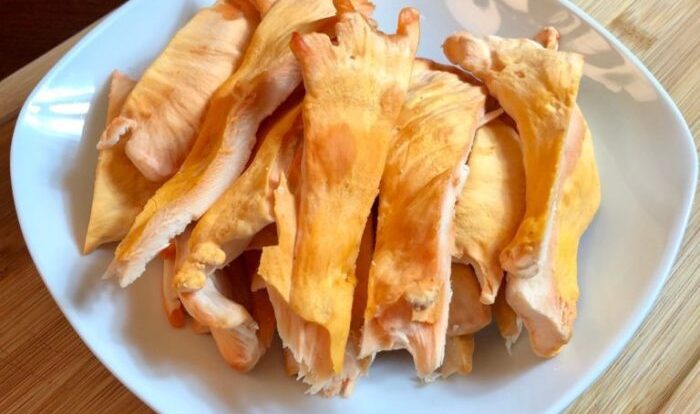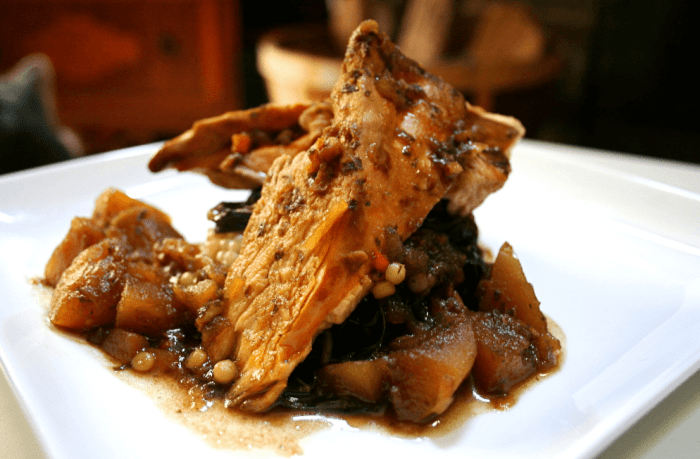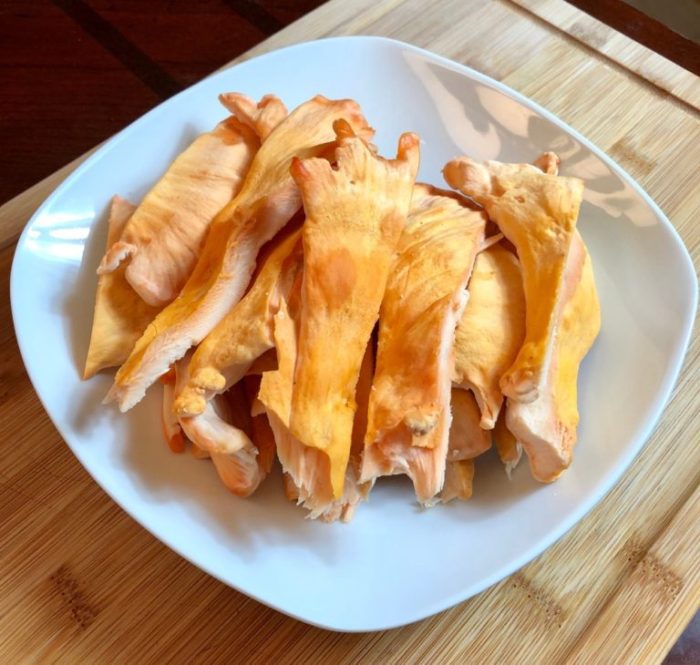
Embark on a culinary adventure with our tantalizing chicken of the woods recipe! Discover the unique characteristics, health benefits, and culinary versatility of this woodland delicacy.
This extraordinary mushroom boasts a vibrant color, succulent texture, and a flavor that will tantalize your taste buds. Its nutritional value and potential health benefits make it a wholesome addition to any diet.
Chicken of the Woods: A Culinary Delight

Chicken of the Woods is a prized edible mushroom known for its striking appearance and delectable flavor. Resembling a cluster of chicken feathers, this mushroom typically grows on oak or chestnut trees during the summer and fall months.
Its unique characteristics set it apart from other mushrooms. The bright orange or yellow caps, which can grow up to 12 inches wide, are adorned with velvety pores instead of gills. The firm, meaty texture and mild, nutty flavor make it a versatile culinary ingredient, suitable for various cooking methods.
Nutritional Value
- Rich in fiber, protein, and antioxidants
- Low in calories and fat
- Contains vitamins B, C, and D
- May have anti-inflammatory and immune-boosting properties
Health Benefits
Chicken of the Woods is a nutritionally dense mushroom with an impressive array of health benefits. It is a rich source of vitamins, minerals, and antioxidants.
Antioxidant Properties
Chicken of the Woods is a potent antioxidant. It contains a variety of compounds that help protect cells from damage caused by free radicals. Free radicals are unstable molecules that can contribute to the development of chronic diseases such as cancer and heart disease.
Studies have shown that Chicken of the Woods extract can scavenge free radicals and inhibit lipid peroxidation, a process that can damage cell membranes.
Anti-inflammatory Properties
Chicken of the Woods also has anti-inflammatory properties. It contains compounds that can help reduce inflammation throughout the body. Inflammation is a major contributing factor to many chronic diseases, including arthritis, heart disease, and cancer.
If you’re looking for a delicious and easy-to-prepare wild mushroom dish, check out this chicken of the woods recipe . Chicken of the woods is a large, orange mushroom that’s common in North America. It has a meaty texture and a slightly sweet flavor, making it a great substitute for chicken in vegetarian and vegan dishes.
Studies have shown that Chicken of the Woods extract can inhibit the production of inflammatory cytokines, which are proteins that promote inflammation.
Culinary Applications of Chicken of the Woods

Chicken of the Woods is a versatile mushroom that can be used in a variety of culinary applications. It has a meaty texture and a slightly nutty flavor that makes it a great substitute for chicken in many dishes.
Simple Preparations
One of the simplest ways to prepare Chicken of the Woods is to sauté it in butter or oil. This method is quick and easy, and it allows the mushroom’s natural flavors to shine through. You can also add other ingredients to the sauté, such as onions, garlic, or herbs.
If you’re looking for a unique and flavorful vegetarian dish, consider trying a chicken of the woods recipe . This mushroom is a great source of protein and has a meaty texture that makes it a perfect substitute for chicken.
The chicken of the woods recipe is easy to follow and can be tailored to your own taste preferences. You can sauté, grill, or roast the mushrooms, and add your favorite spices and herbs.
Complex Dishes
Chicken of the Woods can also be used in more complex dishes, such as soups, stews, and casseroles. It adds a rich, earthy flavor to these dishes and can be used as a main ingredient or as a supporting player.
You can also use Chicken of the Woods to make vegetarian or vegan versions of classic dishes, such as chicken pot pie or chicken and dumplings.
Pairing Suggestions
Chicken of the Woods pairs well with a variety of ingredients and flavors. It can be paired with other mushrooms, such as shiitake or oyster mushrooms, or with vegetables, such as onions, garlic, or carrots. It also pairs well with herbs, such as thyme, rosemary, or sage.
When it comes to flavors, Chicken of the Woods pairs well with savory flavors, such as garlic, onion, and soy sauce. It can also be paired with sweet flavors, such as honey or maple syrup.
4. Foraging and Identification

Foraging for Chicken of the Woods requires a keen eye and an understanding of its habitat and characteristics. Here’s a guide to help you identify and responsibly harvest this culinary delicacy.
Habitat and Growing Season
Chicken of the Woods typically grows on the base or stumps of dead or dying hardwood trees, especially oaks. It thrives in moist, shady forests and can be found from late summer to fall.
Identification, Chicken of the woods recipe
- Shape and Size:Chicken of the Woods forms shelf-like or bracket-shaped clusters that can range from small to large, measuring up to 12 inches in width.
- Color:The mushroom is characterized by its vibrant orange to yellow-orange coloration, with a smooth or slightly velvety texture.
- Flesh:The flesh is firm and white when young, becoming slightly tougher with age. It has a mild, slightly fruity flavor and a pleasant aroma.
- Spores:The spores are white and produced on the underside of the mushroom’s cap.
- Look-alikes:False Chicken of the Woods ( Laetiporus sulphureus) is a close look-alike but has a more yellow coloration and a sulfurous odor.
Responsible Foraging Practices
When foraging for Chicken of the Woods, it’s important to follow responsible practices to ensure the sustainability of this natural resource:
- Leave Some Behind:Only harvest a portion of the mushroom, leaving enough behind for other foragers and wildlife.
- Respect the Tree:Do not damage the tree by hacking at the mushroom. Use a sharp knife to carefully remove the mushroom from the base.
- Check for Insects:Inspect the mushroom thoroughly for any insects or larvae before consuming it.
li> Cook Thoroughly:Always cook Chicken of the Woods thoroughly before eating it, as it may contain toxins that can cause digestive upset.
Final Thoughts: Chicken Of The Woods Recipe
Whether you’re foraging in the woods or cultivating it at home, chicken of the woods offers a rewarding culinary experience. Experiment with our diverse recipes to create mouthwatering dishes that will impress your palate and nourish your body.
FAQ Guide
What are the health benefits of chicken of the woods?
Chicken of the woods is rich in antioxidants and anti-inflammatory compounds, making it a potential aid in boosting immunity and reducing inflammation.
Can I cultivate chicken of the woods at home?
Yes, chicken of the woods can be cultivated using specific substrates and growing conditions. However, it requires patience and attention to detail.
How do I identify chicken of the woods safely?
Look for mushrooms with bright orange or yellow coloration, a velvety texture, and a slightly bitter taste. Avoid consuming any mushroom you cannot confidently identify.





